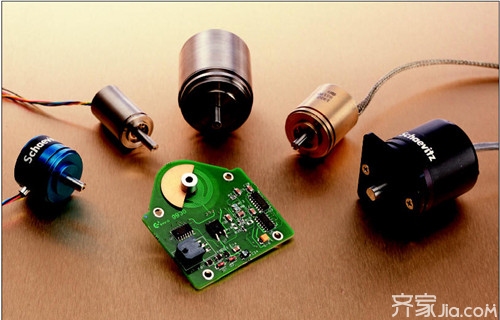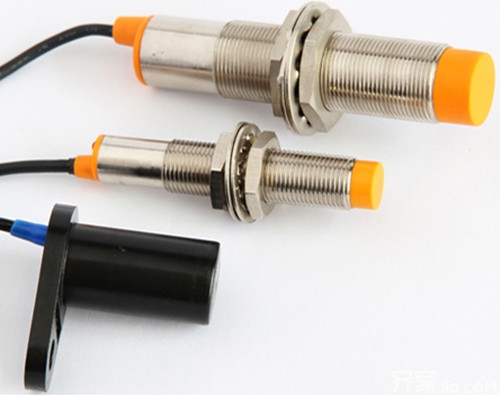The sensor is an integral part of the sensing system and it is the first gate to which the measured signal is input. The sensor converts some form of energy into another form of energy. What are the sensor types ? There are many classification methods for sensors, but there are two commonly used classification methods, one is to divide the measured physical quantity; the other is divided according to the working principle of the sensor. Let's take a look at the relevant knowledge of sensor types .

Sensor introduction
The national standard GB7665-87 defines the sensor as follows: "A device or device that can sense a specified part to be measured and convert it into a usable signal according to a certain law (a mathematical function rule), usually consisting of a sensitive element and a conversion element."
The China Internet of Things school-enterprise alliance believes that the presence and development of sensors will allow objects to have senses such as touch, taste, and smell, allowing objects to gradually become alive. â€
"Sensor" is defined in the New Wexar dictionary as: "Receive power from one system, and usually send power to devices in the second system in another form".
sensor type
There are many classification methods for sensors, but there are two commonly used classification methods, one is to divide the measured physical quantity; the other is divided according to the working principle of the sensor. According to the measured physical quantity, the common sensors include temperature sensor, humidity sensor, pressure sensor, displacement sensor, flow sensor, liquid level sensor, force sensor, acceleration sensor, and torque sensor.
According to the working principle can be divided into:
1. Electric sensor Electric sensor is a kind of sensor with a wide range of applications in non-electricity electricity measurement technology. Resistive sensor, capacitive sensor, inductive sensor, magnetoelectric sensor and eddy current sensor are commonly used. Resistive sensors use varistors to convert measured non-electrical quantities into resistive signals.
Resistive sensors are generally potentiometer-type, contact resistance resistance, resistance strain gauges and piezoresistive sensors. Resistive sensors are mainly used for the measurement of parameters such as displacement, pressure, force, strain, torque, airflow velocity, liquid level and liquid flow.
Capacitive sensors are made using the principle of changing the capacitance of the capacitor or changing the nature and content of the medium so that the capacitance changes. It is mainly used for measuring pressure, displacement, liquid level, thickness, moisture content and other parameters.
The inductive sensor is made by changing the magnetic circuit geometry, the position of the magnet to change the inductance or mutual inductance or magnetic pressure effect principle. It is mainly used for measuring parameters such as displacement, pressure, force, vibration and acceleration.
Magnetoelectric sensors use the principle of electromagnetic induction to convert non-quantity measured into electricity. It is mainly used for the measurement of parameters such as flow rate, rotation speed and displacement.
The eddy current sensor is made by using the principle that gold shavings move in the magnetic field to cut magnetic lines and form eddy currents in the metal. It is mainly used for measuring parameters such as displacement and thickness.
2. Magnetic sensors Magnetic sensors are made by using some of the physical effects of ferromagnetic materials, mainly used for the measurement of displacement, torque and other parameters.
3, photoelectric sensor photoelectric sensor in the non-electricity electricity measurement and automatic control technology occupies an important position. It is made by using photoelectric effect and optical principle of optoelectronic devices, and is mainly used for measuring parameters such as light intensity, luminous flux, displacement, and concentration.
4. Potential-type sensor The potential-type sensor is made using thermoelectric effect, photoelectric effect, Hall effect and other principles. It is mainly used for the measurement of parameters such as temperature, magnetic flux, current, speed, light intensity, and heat radiation.
5, the charge sensor Charge sensor is made using the principle of piezoelectric effect, mainly for the measurement of force and acceleration.
6, semiconductor sensor semiconductor sensor is the use of semiconductor piezoresistive effect, the internal photoelectric effect, magnetoelectric effect, semiconductor and gas contact with the principle of substance changes made mainly for temperature, humidity, pressure, acceleration, magnetic field and harmful gases measuring.
7. Resonance sensor Resonance sensor is made by changing the principle of electrical or mechanical parameters to change the resonant frequency. It is mainly used to measure pressure.
8. Electrochemical Sensors Electrochemical sensors are based on ion conduction. According to their different electrical characteristics, electrochemical sensors can be classified as potential sensors, conductance sensors, power sensors, polarographic sensors, and electrolytic types. Sensors, etc. Electrochemical sensors are mainly used for the analysis of gas, liquid or solid components dissolved in liquids, the pH, conductivity, and oxidation-reduction potential of liquids.
In addition, according to the detection and conversion process of the sensor on the signal, the sensor can be divided into two categories: a direct conversion sensor and an indirect conversion sensor. The former converts the non-electrical energy input to the sensor to electrical signal output. If the photoresistor is exposed to light, the resistance value will change, and the optical signal will be directly converted into an electrical signal output; the latter will be input to the sensor. The non-electricity is first converted into another non-electricity, and then converted into an electrical signal output. For example, a pressure sensor made of a spring tube sensor belongs to this type. When a pressure is applied to the spring tube, the spring tube deforms. The sensor then converts the deformation into an electrical signal output.

Common sensors in life
1, the temperature sensor
species
<1>, digital signal output sensor type and application occasion: DS18B20, 18B20 digital temperature sensor, can be applied to all kinds of narrow space equipment digital temperature measurement and control field.
<2>, thermistor sensor type and application: Thermistor 5K10K temperature sensor temperature, probe.
<3>, MTS102 temperature sensor temperature range: -40 ~ +150 °C.
2. Ultrasonic sensors
species:
<1> Ultrasonic Sensor TCT40-16F/S (Send/Send).
<2>, ultrasonic sensor TCT40-16F/S (transceiver integrated).
<3>, ultrasonic distance measuring module, maximum detection distance 5m.
<4>, ultrasonic ranging module, can be directly installed on the robot, as a search for objects, obstacle detection and other applications.
3, acceleration sensor
Types and Applications: MMA7660MMA7660FC Ultra-low-power, low-power triaxial accelerometer, triaxial accelerometer, can be used for tilt control of carts, robots, etc.
4, gas smoke sensor
<1>. The smoke sensor MQ-2 can be used to detect combustible gases such as CO and CH4.
<2>, alcohol sensor MQ-3, semiconductor alcohol sensor MQ-3.
5, humidity sensor: humidity sensitive resistors, humidity sensitive components, with a wide range of moisture, high sensitivity, low hygroscopic enthalpy difference, fast response.
6, vibration sensor / displacement sensor: CLA-3.
7, Hall switch sensor: Hall switch sensor / motor speed / position detection, can be used for motor speed / position detection and other fields,
8, wireless remote control set up: 315M, commonly used in alarm fortification, garage door remote control, motorcycle, car burglar alarm.
9,24GHz radar sensor, which is a kind of equipment that can convert the microwave echo signal into an electric signal. It is a core chip of radar speedometer, water level gauge, automobile ACC auxiliary cruise system, automatic door sensor and so on.

10, photoelectric sensor photoelectrictransducer, based on the photoelectric effect of the sensor, after being exposed to visible light photoelectric effect, the optical signal is converted into electrical signal output. In addition to measuring light intensity, it can also use light transmission, shielding, reflection, interference to measure a variety of physical quantities, such as size, displacement, speed, temperature, etc., and thus is an important and widely used sensitive device. When the photoelectric measurement is not in direct contact with the measured object, the beam quality is approximately zero. There is no friction in the measurement and almost no pressure is applied to the measured object. Therefore, in many applications, photoelectric sensors have obvious advantages over other sensors. The disadvantage is that in some applications, optical devices and electronic devices are expensive, and require higher measurement environmental conditions. Sagitar steering wheel angle sensor is a photoelectric sensor.
11. An air quality sensor, which is a sensor made by semiconductortransducer using various physical, chemical, and biological properties of a semiconductor material. Most of the semiconductor materials used are silicon and III-V and II-VI elemental compounds. A wide variety of semiconductor sensors, it uses nearly 100 kinds of physical effects and material characteristics, with similar to human eyes, ears, nose, tongue, skin and other sensory functions.
12, sensor, air flow sensor is a sensor that measures the air flow into the engine. Electronically Controlled Gasoline Injection A flow sensor system is required to measure the amount of air taken into the engine at each moment in order to obtain the optimum concentration of the mixture in all operating conditions. The main basis. If the air flow sensor or the line fails, the ECU cannot obtain the correct intake air quantity signal, and the control of the fuel injection amount cannot be normally performed, resulting in the mixture being too rich or too lean and causing the engine to operate abnormally.
13, position sensor, also known as the synchronization signal sensor, it is a cylinder discriminating and positioning device, to the ECU input camshaft position signal, is the ignition control of the main control signal. There are two types of crankshaft position sensors and camshaft position sensors.
14, sensor, when the oil into the container caused by the sensor shell and the sensing electrode capacitance changes, the change in the amount of change through the circuit and accurate linearity and temperature compensation, output 4-20mA standard signal to the display instrument. Location: Oil pan area.
Editor's summary: The above is the introduction of the common sensor types in the inventory market. I hope to be able to help friends who have this need! For more information, please continue to pay attention to our website, follow-up will show more exciting content. You can also purchase your favorite product on Qijia Mall!
High Temperature Pressure Sensor Switch Sensor Load Cell Liquid Sensor Level Sensor Sensor Type
Color Eva Film,Eva Adhesive Film,Color Eva Films,Color Movie Film
HUAKAI FENGSHI TECHNOLOGY (CHONGQING) CO., LTD. , https://www.cqhkpvb.com